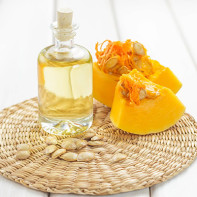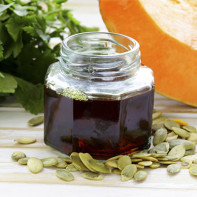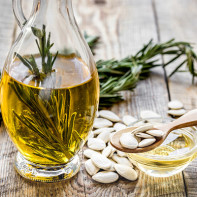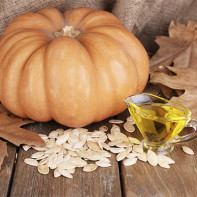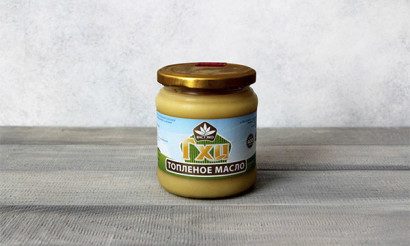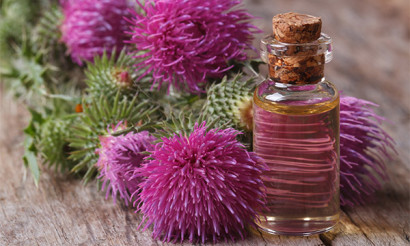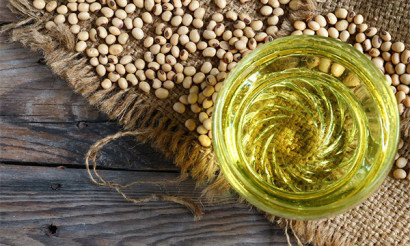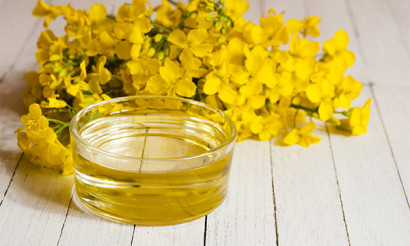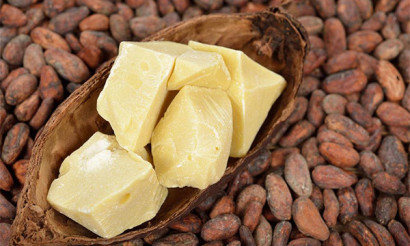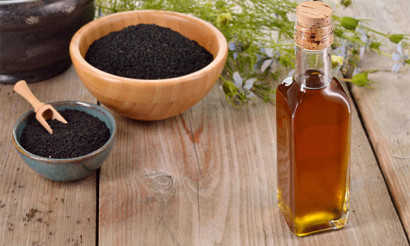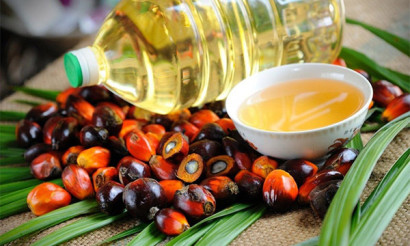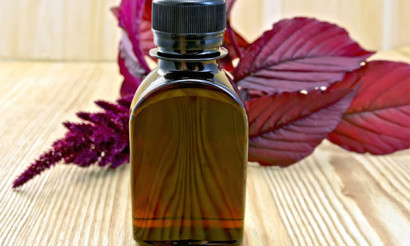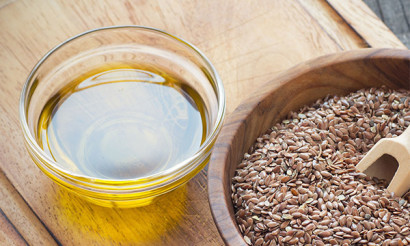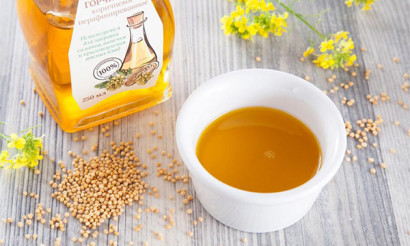Pumpkin seed oil: composition, useful properties and contraindications
Almost all vegetable oils are beneficial. But pumpkin oil in many ways superior even to olive oil, which is considered the most useful. It is widely used in cooking, added to soups, salads, desserts, but it can also be taken as a medicine.
- Composition and calories
- Useful properties of pumpkin seed oil
- General benefits
- For women
- For men
- For Pregnancy
- For breastfeeding
- For children
- Slimming
- Pumpkin seed oil in capsules
- Pumpkin oil in medicine
- Diabetes mellitus
- In pancreatitis
- For Gastritis
- For Intestines
- When constipation
- For colitis
- For the liver
- For hemorrhoids
- For cholecystitis
- For prostatitis
- For worms
- Pumpkin seed oil in cosmetology
- For Face
- For Hair
- Using Pumpkin Oil in Cooking
- Salad with Baked Beets
- Chicken salad with pumpkin oil
- Can I Fry in Pumpkin Oil?
- Hazards and Contraindications
- How to Choose and Store Pumpkin Oil
- How to Drink Pumpkin Oil Properly
- Can I drink it at night and on an empty stomach?
- How to Make Pumpkin Oil at Home
- Interesting Facts about Pumpkin
Composition and Calorie
The energy value of pumpkin seed oil is quite high - 898 kcal per 100 g. But at the same time it is considered a dietary product. First of all, you can't eat a lot of butter anyway. And secondly, it contains many useful substances. Many of them have a multidirectional effect, but all together they provide the healing properties of this product.
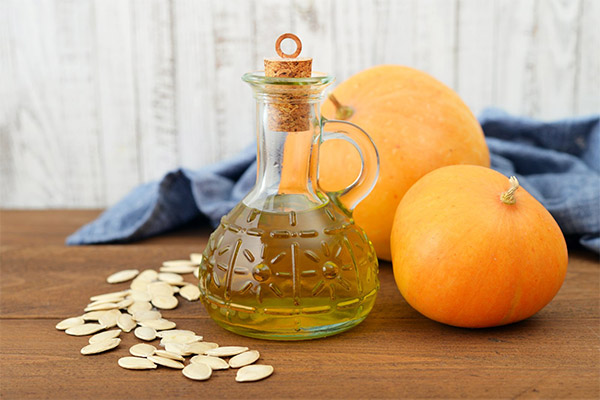
The composition of pumpkin seed oil includes:
- Fatty acids - stearic, linoleic, palmitic. Many people have a prejudice against fats. However, in fact, these elements can be beneficial to health. Pumpkin seed oil contains about 90% unsaturated acids, which generally help stabilize blood pressure and remove "bad" cholesterol.
- Biologically active substances. This is a very large group that includes substances with antioxidant and anti-inflammatory effects. It includes carotenoids, flavonoids, and tocopherols. Also biologically active components include phospholipids and phosphatides.
- Minerals, macro- and microelements. The seeds from which this product is made contain more than 50 such substances, all of which go into pumpkin seed oil. The most important of these are considered to be phosphorus, calcium, magnesium, selenium, iron, and zinc with its anti-inflammatory properties. Some of these elements, such as potassium and magnesium, are necessary for normal heart muscle function.
- Ascorbic acid, vitamins K and P, as well as B vitamins responsible not only for the condition of the CNS, but also for metabolic processes.
A special role is played by the enzyme phosphatidylcholine, which is contained in pumpkin seed oil. It performs an important role - it activates lecithin, another enzyme that is necessary to ensure that cholesterol remains in a liquid state, rather than turning into deposits on the walls of blood vessels. The presence of both of these enzymes makes pumpkin seed oil an indispensable product for those people who suffer from cardiovascular disease.
Substances in pumpkin oil help to increase the elasticity of vascular walls, participate in the synthesis of hemoglobin, have anti-allergic and anti-inflammatory properties. They speed up metabolic processes, relieve swelling, improve blood microcirculation. Due to the fact that pumpkin seed oil contains substances that nourish tissues, stimulate trophic exchange, there is a more rapid recovery.
Useful properties of pumpkin seed oil
General benefits
Due to its unique chemical composition, pumpkin oil is recommended in the following cases:
- For the normalization of metabolic processes.
- Treatment and prevention of atherosclerosis and cardiovascular diseases.
- Treatment of adenoma of the prostate and chronic prostatitis, because it has both analgesic and anti-inflammatory, androgenic effect.
- The therapy and prevention of bladder diseases - the oil not only relieves pain, but also makes it easier to urinate.
In addition, it is used as a healing agent for burns and even frostbite. They smeared it on the affected areas of the skin in all diseases, including acne.
For women
Pumpkin oil for women is useful because it has not only anti-inflammatory properties, but also the ability to normalize the hormonal background. Therefore, this product is used to restore reproductive function and normalize the menstrual cycle. And due to the fact that pumpkin seed oil improves blood circulation, it is appointed in the treatment of varicose veins, and to eliminate congestion in the pelvic organs. In gynecological diseases of inflammatory nature, it is taken in combination with antibiotics.
To achieve the desired effect, you need to use pumpkin seed oil regularly, the minimum duration of treatment should be two weeks. The optimal dosage is considered 4-5 drops of oil to be drunk in its pure form.
In some gynecological diseases is recommended external application of the oil in the form of vaginal applications. To do this, it is soaked in tampons, which are placed for up to 30 minutes. Very often this remedy is used for erosions, but only after consultation with a gynecologist.
Cystitis is an inflammatory disease of the bladder, which is usually encountered only by women, it occurs very rarely in men due to physiological characteristics. It is most often of a bacterial nature, and its treatment requires antibiotics. Pumpkin seed oil is used in the complex treatment of cystitis. It is taken literally 8-10 drops three times a day, without drinking. This is enough to relieve the pain.
For men
For the stronger sex, pumpkin seed oil is useful not only for its positive impact on the cardiovascular system, but also because it contains substances that normalize erectile function. Zinc eliminates inflammation, other substances improve urination and eliminate discomfort in the bladder associated with an enlarged prostate.
Studies have shown that pumpkin seed oil slows down the pathological increase in size of the organ. And it is an excellent preventive agent against atherosclerosis, including brain vessels, prevents heart attacks, strokes and many other troubles.
When pregnant
For expectant mothers, pumpkin seed oil is especially useful in the first trimester, it helps to fight nausea and normalizes digestion. Later on, this product also helps to eliminate constipation, which many women face during pregnancy. But during this period, it is best to use pumpkin seed oil to dress salads in small amounts twice a day. Take internally as an independent therapeutic agent only in very small amounts, no more than 3 times 4 drops per day.
Pumpkin seed oil as a mild laxative is used during pregnancy in the form of a composition for microclysters. The dosage for rectal injection is only 20 ml.
When breastfeeding
During pregnancy and in the postpartum period, many women face inflammatory diseases of the genitourinary system, even if such pathologies have never bothered them before. Pumpkin seed oil helps to relieve inflammation and get rid of these problems.
In addition, during pregnancy and after childbirth a woman's body often faces a shortage of vitamins, which is not surprising, because first all the elements that come with food are spent on the development of the baby's body, and later - on milk production. Because of this, the condition of the skin, hair and nails deteriorates. Consumption of pumpkin seed oil helps to restore the skin youthfulness, make it more elastic and firm. This product also strengthens the hair and stops its loss, makes it shiny and silky.
The use of pumpkin seed oil in the postpartum period is very useful for the digestive system, mainly for the treatment and prevention of constipation. And the product not just increases intestinal peristalsis, but also improves the absorption of useful substances.
But pumpkin seed oil should be drunk with caution, checking whether there is no allergic reaction in the baby. You should start with the minimum dose, gradually increasing it.
For children
Pumpkin seed oil can be used not only for adults, but also for children of the first year of life. However, for babies of this age, only external use is allowed. In such cases, pumpkin seed oil is used as a mild laxative for constipation, it also lubricates skin irritations. But still need to use it with caution. If the skin is red, there is a rash, from pumpkin seed oil have to give up.
The ration of the child can not introduce it to three years, and after that age even some time baby can be given no more than 2-3 ml of oil a day, adding to vegetable dishes or porridge. As a remedy, for example to improve vision, it is given only to children and teenagers over the age of 12.
For weight loss
The unique chemical composition of pumpkin oil described above makes it ideal for weight loss, because the substances contained in this product break down fats and normalize lipid metabolism. Moreover, they prevent the appearance of the fat layer in the most problematic areas - for example, on the buttocks and thighs, in the abdomen, etc. In addition, thanks to the normalization of digestion, this oil helps to actively remove toxic substances from the body. It improves all metabolic processes, including in the lymphatic system, so that its use can avoid cellulite.
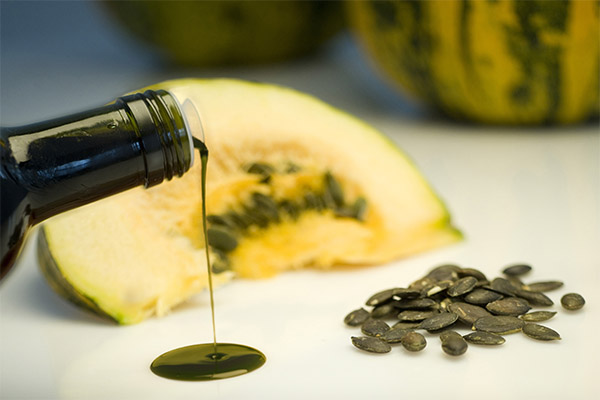
For weight loss, pumpkin seed oil can be taken in several ways. But in any case, it should remain cold, because when heated, its useful substances are simply destroyed.
The main ways of consuming pumpkin seed oil for weight loss:
- On an empty stomach. This method is suitable only for those who can consume the oil in its pure form, without drinking it. Take the medicine on an empty stomach, the maximum amount - 1 tsp. In 15-30 minutes after this, you can have breakfast, with no buns in the menu should not be. Not everyone likes the taste of pumpkin seed oil, so you can add a little honey to it. The optimal duration of this treatment is three weeks. After that, you have to take a break for a month, during which you should also control your diet. Then, if necessary, the course can be repeated.
- Salad dressing. If purely physically difficult to drink pure oil, it can be used for salad dressing. But then it will be the only dish that can be eaten for dinner. Therefore, it is better to choose such recipes, where not only vegetables are used as ingredients, but also lean meat. The duration of the course is three weeks. Then you should take a break for two weeks, then you can return to this diet again.
- As an additive to fermented dairy products. Considering the laxative effect of pumpkin oil, add it to kefir obviously should not be. But you can mix it with honey and apple cider vinegar and use it together with low-fat cottage cheese. It is necessary to take no more than 1 tsp. This will be an excellent option for breakfast. A small amount of oil can also be added to smoothies with yogurt. The duration of application is the same as for salads.
- As an additive to freshly squeezed apple and carrot juice. Here, the oil can be added directly to the glass, no more than 1 tsp. It will not spoil the taste of the drink, but will be useful for the cardiovascular system and help lose weight.
Nutritionists say that this use of pumpkin seed oil helps to lose up to 5-6 pounds per month relatively easily, and this is true. But we should not forget that such an effect can be achieved only if you refuse at the same time from sweets and flour. The advantage of this method is that you do not need to sit on a strict diet, which deprives the body of energy.
The benefits of pumpkin seed oil in capsules
Pumpkin seed oil in capsules is useful because it retains its therapeutic properties. In addition, it is a very convenient form when taken orally, because not everyone can just drink liquid oil. Gelatin capsules are safe, they are perfectly processed by the body. However, they are prescribed only for hyperlipidemia (i.e. obesity), liver lesions and the treatment of prostate adenoma. In parodontosis, urological and gynecological diseases, this form will do nothing. But in the cases described above it is taken orally:
- For adenoma and chronic prostatitis - 1-2 capsules three times a day;
- Obesity - 1-2 capsules, also three times a day, regardless of meals;
- Liver damage - 3-4 capsules three times a day, but always after a meal;
- For the prevention of atherosclerosis - 1-2 capsules a day.
The duration of treatment determines the doctor. In most cases, take capsules should be 3-4 months. But to prevent atherosclerosis, they can be prescribed for a longer period, and in the treatment of liver disease course can be calculated for 3-4 weeks. It all depends on the specific pathology.
Capsules can not be taken in the presence of gastric and intestinal ulcers in the acute stage, with gastritis, duodenitis, other diseases of the gastrointestinal tract, with calculous cholecystitis (that is, the presence of stones). Also oil in this form is not recommended for pregnant women.
Pumpkin seed oil in medicine
Pumpkin seed oil is recognized by official medicine. It is used in the complex therapy for many diseases. Back in the early 2000s, studies were conducted that proved that the use of pumpkin seed oil exceeds the hypotensive effect of such popular drugs as captopril and felodipine.
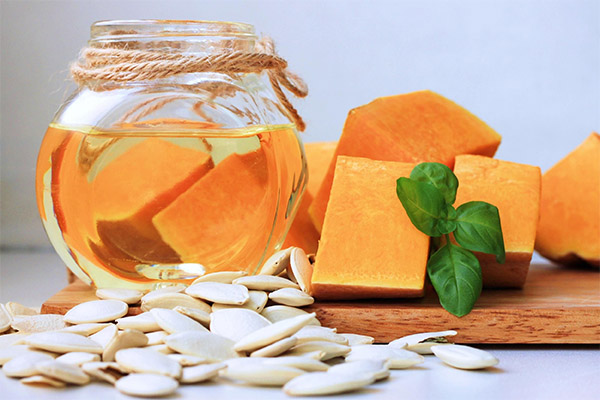
Sometimes it is also used as an independent remedy. For example, pumpkin oil is used in applications for periodontal disease, for hemorrhoids and constipation it is prescribed rectally for microclysters. It is also used to treat gynecological diseases - it is used to make vaginal tampons. And pumpkin seed oil is used as a wound healing agent. It lubricate the affected skin 2-3 times a day.
With diabetes
Pumpkin seed oil is considered useful for diabetes as well. It helps fight its complications, healing sores and wounds and improving eyesight, eliminates the causes of the disease associated with obesity. In addition, pumpkin seed oil contains an ingredient such as D-chiro-isonitol, which increases the sensitivity to insulin and helps regulate blood glucose levels. Because of this, in type 2 diabetes, pumpkin seed oil is considered a very useful product, which is used both internally (to normalize glucose levels and lipid metabolism) and externally to heal wounds.
But for the same reason, pumpkin seed oil is not recommended for type 1 diabetes. In some cases, the doctor may allow a small amount of it, but as a rule, this product is contraindicated. So, you can not introduce it into the diet without the approval of a specialist.
In pancreatitis
It would seem that since pumpkin seed oil has anti-inflammatory properties, you can safely use it with pancreatitis. But in fact, this is not the case. Pancreatitis is an inflammatory disease of the pancreas, and the diet in its treatment is built so as to reduce the amount of fat in the diet, without increasing the load on this organ. For this reason, even raw pumpkin seeds should not be eaten, only dried, which contain less fat.
Pumpkin seed oil is contraindicated in acute pancreatitis and exacerbation of its chronic form. In this case, you can use it only in stable remission - then the product will even be useful, because it will help to restore tissue. But even in this period it is not recommended to consume more than 1 tsp. of oil per day, and best of all - as part of other dishes.
With gastritis
It is believed that pumpkin oil has a beneficial effect on the mucosa of the stomach due to its anti-inflammatory properties, heals its surface. This is partly true, but you should remember that in the acute form of gastritis with hyperacidity, as well as in the exacerbation of chronic disease, pumpkin seed oil should not be used. It can be taken orally only in remission, 1 tsp. an hour before each meal.
In the form of capsules it should not be used even in remission of the disease - it will not bring the expected benefit, but may cause side effects.
For the intestines
For the intestines, pumpkin seed oil is useful because it has a healing effect, as well as giving a laxative effect. But it should be taken with caution - so, with an acute form of peptic ulcer or its exacerbation, this oil is forbidden.
For constipation
Pumpkin seed oil can eliminate various causes of constipation. If it is used as a microclysis, it fights hemorrhoids and heals fissures of the rectum. You only need 5 ml of oil for one treatment, you don't even have to dilute it.
On the other hand, pumpkin seed oil, when taken orally, helps eliminate intestinal peristalsis disorders and normalizes digestion. To do this, you need to take this medicine 1 tsp. in the morning on an empty stomach, without drinking. During the day it is no longer needed to drink. The duration of treatment is 10 days. Repeat such a course if necessary, you can in a month.
With colitis
In this disease, during an exacerbation, it is not recommended to drink pumpkin oil, so as not to provoke a worsening of the situation. However, during remission, this product is necessary to eliminate all the effects of inflammation and prevent its relapse.
For the liver
For the liver, pumpkin seed oil is good because it has hepatoprotective action. It should be drunk in order to normalize the work of this organ. This product is prescribed in the treatment of hepatitis, non-alcoholic cirrhosis, other similar diseases. In general, it is recommended to follow general recommendations, that is, no more than 1-2 tsp. three times a day and only after consulting a doctor.
In addition, pumpkin seed oil is taken to protect liver cells during chemotherapy. It is used to accelerate the rehabilitation of the organ after some operations. In such cases, it is sufficient to take pumpkin seed oil regardless of meals, 1 tsp. once every two days, but for a long time - most often at least a year.
With hemorrhoids
In this disease, it is recommended to use pumpkin oil as microclimaxes - no more than 5 ml at a time. If there is itching or burning, it is recommended to stop using this product.
In cholecystitis
In the acute form of this disease, pumpkin seed oil is contraindicated. Also it can not be taken if there are formed stones in the gallbladder - this will only lead to a worsening of the situation. In chronic form in steady remission, the oil can eliminate bile stagnation and improve metabolic processes. But you can use it only after consulting with your doctor and in small quantities.
With prostatitis
In the acute form of prostatitis, antibiotics are prescribed, pumpkin oil is only an aid. But in the chronic form, it is already considered a full-fledged medicine. It can be taken in liquid form, 1-2 tsp. three times a day, or you can choose capsules and take 1-2 pieces three times a day. However, the decision as to which form is more effective and in what dosage is left to the attending physician.
From worms
Unfortunately, it will not be possible to completely get rid of worms solely with pumpkin oil. But it will enhance the effect of pharmacy drugs and can reduce the side effects of their use. The advantage of this product is that, unlike many pharmaceuticals, pumpkin seed oil can also be used for children (although it is still not recommended for children under the age of three).
Pumpkin oil contains substances that help to eliminate various parasites, including worms. To enhance the effectiveness of this remedy helps cumin. It is recommended to grind the seeds of this spice in a mortar, so that you get 1 tbsp of raw materials. Then pour this amount with a glass of pumpkin seed oil. Pour the mixture into a bottle of dark glass and insist in a cool place for several days, shaking the container periodically. In principle, after 2 days, the remedy is already possible to strain. Adults should be given 1 tsp. infusion in the morning (on an empty stomach) and in the evening (a few hours after the last meal). For children, a half dose is also sufficient.
Pumpkin seed oil in cosmetology
Pumpkin oil in cosmetology is used for the skin of the face, for the care of hands and nails, it is also added to ready-made masks for hair.
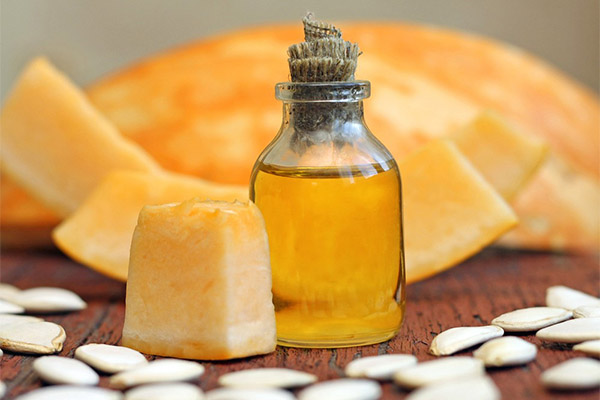
For face
In cosmetology, pumpkin seed oil is often used for dry and fading skin. In this case, it is simply applied with a thin layer on the pre-cleaned skin of the face, including the area under the eyes and around the mouth. The product is left on for half an hour and is not washed off, but simply removes the excess oil with a paper napkin.
But this is only one of its applications, and there are others:
- Pumpkin seed oil is used as a lotion to be applied to the face and body after sunbathing for a beautiful tan.
- To treat coal rash do the following mask: take a clean gauze cloth, fold it several times, moisten it in pumpkin seed oil and put it on the problem areas of the skin for 7-10 minutes. Then the rest is washed off with cool water. This helps to reduce inflammation.
- Nourishing mask with avocado. Take a quarter of this fruit, mashed potato it into a puree, add 2 tsp. pumpkin oil and 1 tsp. cocoa powder and mix everything thoroughly. The resulting mixture is applied to the skin for 30-35 minutes. The mask is first removed with a damp gauze napkin, then wash your face with cool water.
- Anti-aging mask. Take 1 ascarutin tablet, crush to a powder, mix with 3 tsp. starch and 5 ml. pumpkin seed oil. The resulting mixture is applied to steamed skin (better to do the mask after a bath), leave for 30 minutes, then rinse with cold water. Such a remedy perfectly smoothes fine and fine lines and tightens the facial oval.
By the way, pumpkin oil can treat burns, including from prolonged exposure to the sun.
For Hair
Pumpkin oil nourishes the scalp, improves microcirculation, thus ensuring the flow of blood to the hair follicles. It improves the condition of the hair, stimulates hair growth and makes curls more shiny. To get the desired effect, you can simply rub a small amount of oil into the root system for half an hour before washing your head, and then wash it off with a normal shampoo.
However, experts say that in fact a more pronounced effect can be achieved if you first heat the oil in a water bath. It should be warm, not hot. The product is applied not only to the scalp, but also to the strands of hair along its entire length. After that, cover the head with plastic wrap, and wrap it with a terry towel. The remedy should be kept for at least 2 hours, if you want you can even leave it for the night, but then very carefully wash it off with an ordinary shampoo. For the mask to give results, you should make it every other day for at least a month.
As an alternative, one can take 1 tbsp. pumpkin oil and 4 tbsp. bayberry oil, which in this case works as a base, add 5-6 drops of peach oil and 2-3 drops each of rosemary and jojoba essential oils. The mixture is applied to dry hair, put a plastic cap on top and wrap the head with a terry towel. For optimal effect, keep the composition for 1-2 hours, then wash it off with regular shampoo.
Using Pumpkin Oil in Cooking
Pumpkin seed oil has a very pronounced, even pungent smell. Therefore, in cooking, it is used in small quantities, so that it does not interfere with the flavor of other products. Pumpkin seed oil can be added to all sauces, including sweet sauces. A small amount of it is used for already cooked meat and fish dishes to make the taste brighter. Besides, pumpkin oil is added to salads, vinaigrettes, ready side dishes with different casses or pasta and mashed potatoes. It is poured over baked potatoes. A little pumpkin oil can be added to pumpkin, carrot, lentil or pea soup.
In fact, it is a great ingredient for both everyday and holiday menus. For example, you can prepare one of the following salads, which are quite suitable for a dietary diet.
Salad with baked beets.
This salad contains two beets baked in slices, 1 tbsp. pumpkin oil, a bunch of lettuce, 50g of feta cheese (you can use soft cottage cheese), 30g of pine nuts, 1 tsp. mustard, the same amount of balsamic vinegar and liquid flower honey, salt, pepper, oregano, garlic to taste. The garlic cloves are crushed, mixed with the other ingredients of the sauce (oil, vinegar, honey, salt and pepper). The pine nuts are dried in a pan. On a plate spread lettuce leaves, on top - crumbled cheese and slices of beets, then pour the resulting sauce.
Chicken salad with pumpkin oil
For 400g of boiled chicken you need 2 tbsp of apple cider vinegar, 3 tbsp of pumpkin oil, 2 hard-boiled eggs, 2 red bell peppers and 1 tbsp of capers. Mix vinegar and pumpkin oil, add capers, salt and pepper to taste. The chicken meat is cut into portions, then leave for 15 minutes in the marinade. Pepper cut into half rings, eggs - thin slices. Chicken meat with the sauce described above is put on a plate with peppers and eggs on top. If desired, you can decorate with herbs and onions.
In general, in Austrian and German cuisine very often pumpkin oil is mixed with apple cider vinegar. The resulting sauce is used to dress salads not only with meat and vegetables, but also with berries and fruits.
Can I Fry in Pumpkin Oil?
This product should in no case be subjected to serious heat treatment (in this case - burning), from which all its useful substances are destroyed. Therefore, and nothing can be fried in pumpkin seed oil.
Harm and contraindications
Pumpkin seed oil when used in large quantities can give quite a strong laxative effect, cause abdominal discomfort and various dyspeptic symptoms. When used externally, the side effect is a skin allergic reaction such as itching, redness and rash.
It should also be borne in mind that, in addition to the useful components, pumpkin seeds contain salts of heavy metals, particularly high levels of lead and cadmium. Their content in raw materials is strictly regulated by sanitary standards. When it comes to the use of pumpkin seed oil as a medicine, you need to strictly follow the dosage, and you will be fine - even 6 tsp contains very few harmful elements. It is more difficult to control the amount of pumpkin seed oil used in cooking, so it is just important not to get carried away with it.
In addition, you should remember that there are a number of absolute contraindications for the use of this product. Pumpkin seed oil is prohibited in the acute form of gastritis, pancreatitis, colitis, other inflammatory bowel diseases, as well as biliary stone disease.
How to choose and store pumpkin seed oil
High-quality pumpkin seed oil is dark green in color, sometimes even almost black, which is why it was once called "black gold" because it was really expensive. The color can be explained by the fact that the seeds themselves contain a lot of carotene and chlorophyll. Unfortunately, it is not possible to see the shade in the store, because the oil must be sold exclusively in dark glass bottles, so as not to spoil in the light. You can only turn the bottle slightly and see how slowly the viscous oil flows down the walls - it should by no means be liquid.
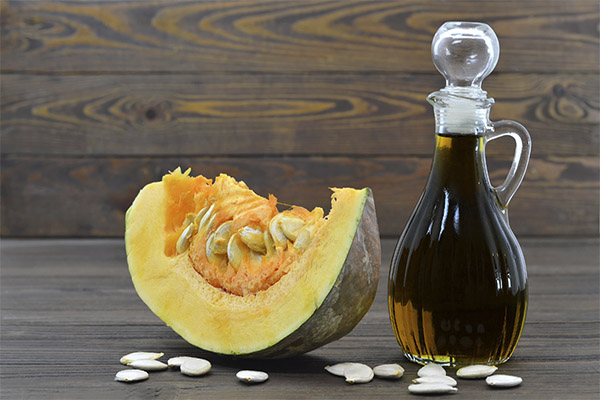
If possible, you should taste the pumpkin seed oil. But even visually you can determine its quality - it is enough to splash a drop on a salad leaf. Quality oil does not drip. As for its taste, it has a nutty notes, it should in no case have a bitterness. The aroma is also very important. At first glance, the smell may seem pungent, but it cannot be called unpleasant. Much depends on the technology of sunflower seeds roasting, but in any case, the oil should smell of sunflower seeds, not of pulp and, of course, not of spoiled fat.
Remember that due to the relatively small yield of the product and the labor intensity of its production, pumpkin seed oil simply cannot be cheap. If its price in the store is lower than the price of olive oil, this should already be alarming.
It is clear that the label should necessarily indicate the manufacturer of this product - and not just the name of the brand, but all the contact information of the company. In addition, on the bottle indicate the date of manufacture and shelf life.
Even the highest quality pumpkin seed oil is stored for no more than 10 months, and only if all the rules are followed. It is poorly tolerant of light and sunlight, so it must be kept in a dark, cool place where the temperature does not exceed +15 ° C. This oil should be kept in a tightly corked dark glass container. Add it to the dish is recommended literally just before serving. After all, if the salad with this dressing will stand in the sun for a while, it will begin to be bitter.
What is the right way to consume pumpkin seed oil?
This oil is considered to be an excellent alternative to animal fats. It contains many vitamins and minerals, some of which no other foods can provide. At the same time, pumpkin seed oil is one of the champions of unsaturated fats. But the body benefits from it only when consumed in relatively small quantities, which is also due to the peculiarities of the chemical composition of the product described above.
The maximum dosage of pumpkin seed oil is 3 tsp. per day. This amount is divided into three meals. It is recommended to drink the oil two hours after a meal or an hour before a meal. It should not be drunk with water. But there are people who find it difficult to take the oil without drinking it. They experience a certain discomfort in doing so. In such cases, you can drink oil with freshly squeezed orange or grapefruit juice, or better - eat it with a small piece of yesterday's bread.
Can I Drink at Night and on an empty stomach?
Many people believe that it is better to take pumpkin seed oil on an empty stomach. There is a certain logic in this - on an empty stomach it is easier to drink the oil, in addition, during this period, the maximum amount of useful substances will be absorbed from the product. But it should be understood that not everyone tolerates taking butter on an empty stomach very well. Therefore, you should start with a very small dosage, gradually increasing it, otherwise you can get side effects in the form of nausea.
As for the maximum dosage, there is no consensus. Some experts say that you can take only 1 tsp. on an empty stomach, and divide the remaining amount into two more doses. Others say that you can take 1 tbsp. of oil in the morning and refuse the next two doses. It is best to be guided by your own body and tolerance of this product in general.
If you do not know what to do, you can do it with your own hands. But you should take into account that it has a slight laxative effect. If a person suffers from constipation, then it is even useful - in the morning he will be able to normalize the situation. But if there is no such a problem, then a peaceful sleep will definitely be broken.
How to make pumpkin oil at home
Algorithm of making oil:
- Select the raw material, pick over the seeds, dry them naturally and peel them.
- Pour the seeds in purified water, making sure that it covers them completely.
- A bowl with water and seeds on the heat for a few minutes, but do not bring to a boil.
- Drain the liquid, and put the seeds in a food processor or blender and grind.
- The resulting mass transfer to a pre-prepared clean gauze, folded in several layers, and squeeze the oil by hand.
The resulting product should also be kept in a tightly corked dark glass container. It will have a shorter shelf life than the oil obtained by industrial method, but considering that you will get only a small amount of it, it is not so important. The more so that the oil can be used immediately for cosmetic or therapeutic procedures, and in this case you can be absolutely sure that it does not contain any harmful substances.
Interesting facts about the pumpkin
Legend has it that in the Middle Ages, a small bottle of pumpkin seed oil would have cost as much as a real, full-blown gold ring. This is most likely a beautiful myth, since in fact the pumpkin did not become widespread in Europe until after the discovery of America. But in the olden days, pumpkin seed oil was really called "black gold. Today, of course, this product does not have a fabulous value, but it is still one of the most expensive types of vegetable oil, because it requires special raw materials and its production uses mainly manual labor.
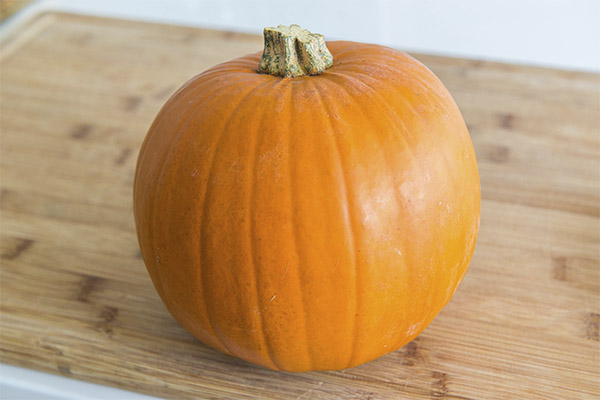
Pumpkin seed oil was first produced in Austria. Today a unique variety of this vegetable is grown here - pumpkin oil Styrian, which received its name after the name of the federal land, where it was grown. The peculiarity of this variety is that its seeds have no husks. From them in Styria produce the most delicious oil in Europe, which has a subtle aroma and a slight nutty flavor. In Russia, pumpkin seed oil was only produced in the 19th century. But, although many breeders have achieved certain successes, no variety compares with the buttery Styrian pumpkin in taste.
However, it would still be unprofitable to grow this pumpkin in mass quantities. To produce 1 liter of oil, 2.5 kg of seeds have to be processed, which is about 30 pumpkins. That is, in order to get 80-160 liters of oil, we would have to grow 5,000 pumpkins, which is a huge crop area. There are only 150 grams of seeds in each pumpkin, and the rest is pulp, which is not used in any way, but left in the field to rot away naturally and become fertilizer for the next year's harvest. This can be considered a terrible waste, since the pulp also contains vitamins, pectins, and many beneficial substances.
Interestingly, the weight of the buttery Styrian pumpkin is only about 8 kilograms on average, although there are varieties in which the fruit weighs in the tens of kilograms. There are even giant varieties that have a single pumpkin weighing up to 800 kg, and they can be 4 m in diameter, but of course this is rare. And oily pumpkins are small and have tender flesh.
As for oil production, in the traditional regions where oily pumpkins are grown, the makers keep the recipe a secret. The fact is that the resulting flavor and aroma depend largely on the temperature of roasting the seeds and the duration of this process. So both of these parameters remain a mystery.
«Important: All information on this site is provided solely for introductory for educational purposes only. Please consult with a health care professional before following any recommendations. specialist before applying any of the recommendations. Neither the editors nor the authors shall be liable for any possible harm caused by materials."

